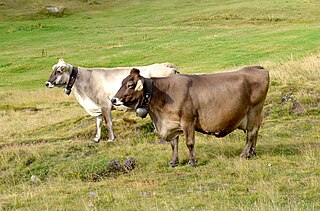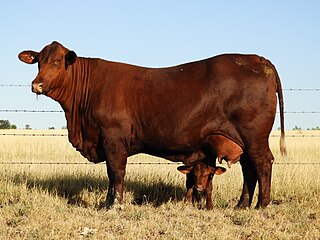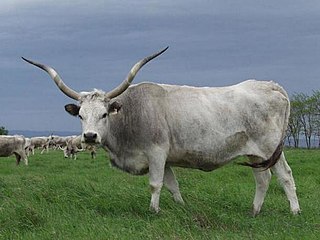Related Research Articles

A breed is a specific group of domestic animals having homogeneous appearance (phenotype), homogeneous behavior, and/or other characteristics that distinguish it from other organisms of the same species. In literature, there exist several slightly deviating definitions. Breeds are formed through genetic isolation and either natural adaptation to the environment or selective breeding, or a combination of the two. Despite the centrality of the idea of "breeds" to animal husbandry and agriculture, no single, scientifically accepted definition of the term exists. It was shown by set-theoretic means that for the term breed an infinite number of different definitions, which more or less meet the common requirements found in literature, can be given. A breed is therefore not an objective or biologically verifiable classification but is instead a term of art amongst groups of breeders who share a consensus around what qualities make some members of a given species members of a nameable subset.

The Charolais or Charolaise is a French breed of taurine beef cattle. It originates in, and is named for, the Charolais area surrounding Charolles, in the Saône-et-Loire department, in the Bourgogne-Franche-Comté region of eastern France. Charolais are raised for meat; they may be crossed with other breeds, including Angus and Hereford cattle.

The Mishima is a critically-endangered Japanese breed of beef cattle. It is found only on Mishima Island, some 50 km north-west of Hagi, in Yamaguchi Prefecture, Japan. It is one of six native Japanese cattle breeds, and one of two small populations that have never been cross-bred with Western cattle, the other being the Kuchinoshima breed from Kuchinoshima island in the Tokara Island group.

The Santa Gertrudis is an American breed of beef cattle. It is a taurine-indicine hybrid breed, descended from both zebu and European cattle. It was bred in the early twentieth century in Texas, and received official recognition in 1940. It has been exported to many countries including Australia, Brazil and South Africa, and has contributed to the development of a number of modern breeds, among them the Barzona and the Droughtmaster.

The Hungarian Grey, also known as the Hungarian Grey Steppe, is a Hungarian breed of beef cattle. It belongs to the group of Podolic cattle and is characterised by long lyre-shaped horns and a pale grey coat. It is well adapted to extensive pasture systems and was formerly raised in very large numbers in the Hungarian puszta. In the twentieth century it came close to extinction, but numbers have since risen.

The Devon is a traditional British breed of beef cattle. It originated in, and is named for, the county of Devon in the West Country of England. It is a deep rich red in colour, and so may be known as the Devon Ruby or Red Ruby; it may also be called the North Devon to distinguish it from the South Devon.

The Japanese Black is a breed of Japanese beef cattle. It is one of six native Japanese cattle breeds, and one of the four Japanese breeds known as wagyū, the others being the Japanese Brown, the Japanese Polled and the Japanese Shorthorn. All wagyū cattle derive from cross-breeding in the early twentieth century of native Japanese cattle with imported stock, mostly from Europe. In the case of the Japanese Black, the foreign influence was from European breeds including Braunvieh, Shorthorn, Devon, Simmental, Ayrshire and Holstein.

The Berkshire is a British breed of pig. It originated in the English county of Berkshire, for which it is named. It is normally black, with some white on the snout, on the lower legs, and on the tip of the tail.

The Japanese Brown is a breed of small Japanese beef cattle. It is one of six native Japanese cattle breeds, and one of the four Japanese breeds known as wagyū, the others being the Japanese Black, the Japanese Polled and the Japanese Shorthorn. All wagyū cattle derive from cross-breeding in the early twentieth century of native Japanese cattle with imported stock, mostly from Europe. In the case of the Japanese Brown, the principal foreign influence was from the Korean Hanwoo and Swiss Simmental breeds.

The Fjäll is a traditional Swedish breed of polled mountain cattle. It was threatened with extinction in the 1970s and 1980s, but recovered after a breed association was formed in 1995, partly thanks to stocks of frozen semen. Microsatellite analysis has shown it to be closely related to the endangered Bohuskulla breed.
Turano-Mongolian cattle are a group of taurine cattle that are found in Northern and Eastern Asia. They are morphologically and genetically distinct from the Near-Eastern group of taurine cattle, from which European cattle are descended; they may have been domesticated independently.

The Estonian Red, Estonian: Eesti punane, is an Estonian breed of dairy cattle. It was developed in the second half of the nineteenth century from cross-breeding of local cattle with imported stock of the Angeln, Danish Red and North Slesvig Red breeds. The coat is red, but sometimes it varies from red-white to brown and rarely black.

The Swedish Red-and-White, Swedish: Svensk Röd och Vit Boskap, frequently abbreviated to SRB, is a Swedish breed of dairy cattle. It was created in the 1920s by crossing the Swedish Red Pied and Swedish Ayrshire breeds.

The Japanese Shorthorn is a breed of small Japanese beef cattle. It is one of six native Japanese cattle breeds, and one of the four Japanese breeds known as wagyū, the others being the Japanese Black, the Japanese Brown and the Japanese Polled. All wagyū cattle derive from cross-breeding in the early twentieth century of native Japanese cattle with imported stock, mostly from Europe. In the case of the Japanese Shorthorn, the principal foreign influence was from the Shorthorn, with some contribution from the Ayrshire and Devon breeds.
The Japanese Polled is a critically-endangered breed of small Japanese beef cattle. It is one of six native Japanese cattle breeds, and one of the four Japanese breeds known as wagyū, the others being the Japanese Black, the Japanese Brown and the Japanese Shorthorn. All wagyū cattle derive from cross-breeding in the early twentieth century of native Japanese cattle with imported stock, mostly from Europe. In the case of the Japanese Polled, the principal foreign influence was from the Scottish Angus breed.

The Kuchinoshima is a critically-endangered Japanese breed of small feral cattle. It is found only on Kuchinoshima Island, in the Tokara Islands in Kagoshima Prefecture in southern Japan. It is one of six native Japanese cattle breeds, and one of two small populations that have never been cross-bred with Western cattle, the other being the Mishima breed from Mishima Island north-west of Hagi, in Yamaguchi Prefecture.
The Kagoshima Berkshire, Japanese: かごしま黒豚, is a Japanese breed of domestic pig found in Kagoshima prefecture in south-western Japan. It derives from the Berkshire breed of pig of the United Kingdom, which was imported to Japan from the 1860s and is now widespread there. The Kagoshima Berkshire apparently descends from two British Berkshire pigs brought to Japan in the 1930s. Meat from this breed may be marketed under the brand name "Kurobuta", meaning "black pig". Pork from Kagoshima Berkshire pigs constitutes approximately 2% of the total annual production in Japan. The meat is considered tender and flavoursome; it is a premium product, in demand throughout the country.
References
- 1 2 3 4 5 Kiyoshi Namikawa (2016 [1992]). Breeding history of Japanese beef cattle and preservation of genetic resources as economic farm animals. Kyoto: Wagyu Registry Association. Archived 20 February 2020.
- 1 2 3 4 5 6 7 Breeds reported by Japan: Cattle. Domestic Animal Diversity Information System of the Food and Agriculture Organization of the United Nations. Accessed January 2017.
- 1 2 3 4 5 6 [National Institute of Agrobiological Sciences] (2005). Country Report: Japan}, annex to The State of the World's Animal Genetic Resources for Food and Agriculture. Rome: Food and Agriculture Organization of the United Nations. ISBN 9789251057629. Archived 30 November 2020.